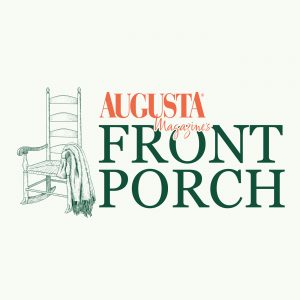Historian Ed Cashin called him “the loneliest man in Augusta.” Every day he would climb the 110 steps up the steel tower past the huge bell to the cupola 90 feet above the intersection of Greene and Eighth Streets. There hour after hour, while buggies and pedestrians passed and kids played on the green far below, he would watch over the city for signs of fire. If he spotted telltale smoke or flames, he would ring that bell, whose gong boomed over the whole city.
“I think there were eight wards in the City, then, watched over from the Bell Tower,” remembered Charlie Benson, who grew up in Augusta in the 1880s. From the tower “in case of undue smoke in the daytime or glare at night, came the deep sound of Big Steve’s alarm ringing out the number of the ward the watchman reckoned the fire to be located in. The volunteer firemen got out of bed, or deserted their business and ran for their respective fire-company’s station, spreading the alarm by loud yells of ‘Fi—yah! – Fi—yah!’ a doleful cry in the night. The market bells took up the alarm, so that there were few in the City unapprised.”
No one remembers the names of the lonely watchmen who took turns in that tower; but that bell was so famous that everyone knew its name: Big Steve. Actually there were two Big Steves; the first 6,000-pound bell was replaced by one 8,000 pounds. Both were named for popular city councilman Stephen Heard.
When the tower came down in 1894, Big Steve was hauled to the steps of the Courthouse and eventually sold to a company in St. Louis. No one knows what happened to it after that.
Augusta was once full of bells. In the days before wristwatches and telephones (not to mention smartphones and tablets), bells tolled the hours, boomed out news, signaled shift changes at the mills, called children to school on weekdays, summoned families to church on Sundays, warned of danger, celebrated holidays.
That is why, says Rudy Volkmann, bells “deserve a place in any discussion of Augusta’s history. They deserve recognition; they deserve to be registered and cataloged; they deserve to be preserved. As Augusta’s older buildings are lost or renovated to different uses, these bells are in danger of being lost in the process. Recognizing, identifying, and listing, them would be a positive step towards ensuring their perpetuity.”
So Volkmann, retired chair of the music department at Paine College, has made it his mission to inspect, photograph, and catalog every historic bell in Augusta. To date he has completed work on 15 downtown churches and is seeking permission to inspect another four—all free of charge. He has also examined the bells and towers in the King and Sibley mills; he has not yet been able to access the tower of the Sutherland Mill, where he thinks a bell must once have hung.
With the coming of electricity, telephones, radios, and modern communication technologies, bells lost their role in the life of the city. As old buildings came down, their bells were sold or melted down or stored and forgotten. Volkmann has found a few of them. The bell that once hung in the original Sacred Heart Church building (Red Cross headquarters today) now hangs above Fort Gordon’s Bicentennial Chapel; it’s unlikely that anyone there knows of its historic significance. The fire bell that replaced Big Steve hung above the firehouse on Broad Street (now the Marbury Center); that bell now decorates a flagpole at the fire station on Reynolds Street. The old Richmond County Courthouse bell now resides in nearby Bath, part of a family bell collection.
Then there are what Volkmann calls the “mystery bells.” Curtis Baptist’s original wooden church building in the late 19th century had a bell. Church records indicate that when the congregation built a new sanctuary, they gave that bell to a nearby “colored” church in the early 1920s. Which one? Is it still there? And what of the magnificent old post office? It stood at the southwest corner of Greene and Ninth Streets from the late 1800s to the 1970s when it was demolished, and old photographs show a massive central tower looming over the Victorian structure. A bell must have hung there. Did it? If so, what happened to it? Does anyone remember? Are there any records?
Most people know Volkmann as either a musician or a fencing master. As a musician he composes and conducts, and for years he performed with the Augusta Jazz Project, the Savannah River Brassworks quintet and the Channelheimers Oompah Band. As a fencer he achieved an international ranking. He wrote America’s best-selling book on fencing and is owner and chief instructor of the Augusta Fencers Club.
Until recently, the only bell he knew anything about was the bell of his beloved tuba. Then in 2006 he was asked to take a look inside the soaring, slender steeple of First Christian Church at Seventh and Greene. Volkmann took measurements, undertook necessary repairs to the structure, and fell in love with the magnificent bell, which has swung there every Sunday since 1875.
“Here was something I didn’t know anything about. All my life I’ve looked around and found stuff that I thought was interesting that I didn’t know anything about and I’d go find out more about it. It occurred to me I’d never seen anything on historic bells in Augusta. It was an old town and probably had some really old bells that needed to be noted–and there was nothing there, nothing at all!”
However, his growing interest wasn’t all about historic preservation. Volkmann chuckled. “Part of it of course is that little kid thing: I’d love to get up there and look at that thing!” he admitted.
In 2017 his curiosity morphed into a serious project: to identify, measure, describe, and catalogue the historically significant bells in and around Augusta. So far he has inspected bells at First Christian, St. Paul’s, First Presbyterian, First Baptist, Holy Trinity Catholic, Central Christian, Christ Episcopal, Sacred Heart, Springfield Baptist, St. James Methodist, Tabernacle Baptist, Thankful Baptist, Union Baptist, Unitarian Universalist, Good Shepherd Episcopal, Sibley and King Mills, and Augusta University. In instances where the bell tower is inaccessible, he can at least sneak a peek and take a picture with a drone.
In the process he has learned a lot. Bells can be made of steel or bronze. Steel bells are often blank, but bronze bells are usually inscribed with significant historical information–the name of the foundry, the date of the casting, and sometimes the names of those who commissioned the bell or the person whom the bell honors. The Springfield Baptist bell lists the church’s trustees; the Sibley Mill bell lists the mill’s original directors and is inscribed with the name “Josiah” for Josiah Sibley. While First Presbyterian’s bell has no date, the Doolittle foundry, whose name is inscribed on it, went out of business in 1811, so the bell could not date from later than that. It is Augusta’s oldest bell (though Volkmann found an older one, a small one, in Louisville, dated 1722). The biggest was certainly Big Steve, which was five feet tall and had a 73-inch diameter. Volkmann suspects it still hangs somewhere in St. Louis.
Volkmann’s inspections have often revealed serious concerns. “Some of these bell towers are a little dangerous. Bells need maintenance. They are these very heavy things swinging back and forth, straining their yokes and everything else. One church has jury-rigged and rehung their bell and it’s not stable. That bell weighs a couple of tons. If it falls, there’s not a lot that will keep it from ending up in the dirt at the bottom of the belfry.”
So Volkmann recommends that churches assess their bells periodically. “Some churches do that,” he says. “But I climb into some towers and I can tell I’m the first person who’s been up there in decades.”
At times like that, as he climbs old steps and ladders while the street noises recede below, Volkmann is a 21st-century heir to that loneliest man in Augusta a century-and-a-half ago, alone in a high tower hung with a bell.
—
Photo by Mark Albertin
Article appears in the November/December 2018 issue of Augusta Magazine.






